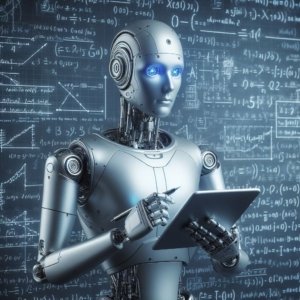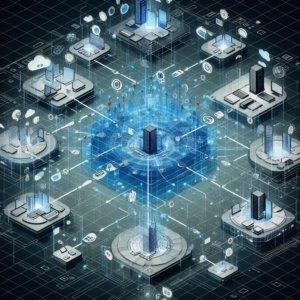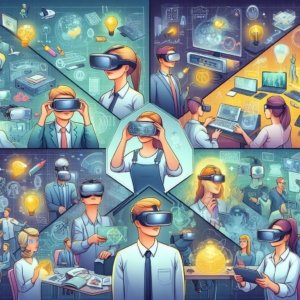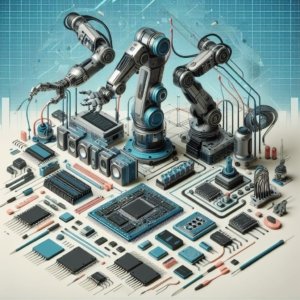Comprehensive Technology Trends Reshaping Business Operations in 2024
As businesses navigate the dynamic landscape of 2024, the confluence of transformative technologies extends far beyond the well-established domains of AI, IoT, and blockchain. This exploration goes deeper, encompassing a myriad of trends that collectively reshape the very fabric of business operations. Beyond the familiar realms, we delve into additional areas such as edge computing, augmented reality (AR), virtual reality (VR), robotics and automation, biotechnology and genomics, cybersecurity beyond AI, and smart agriculture. Each of these trends contributes uniquely to the unfolding tapestry of the tech revolution.
Artificial Intelligence (AI)
 Artificial Intelligence (AI) stands as a dynamic field within computer science, central to technological advancements and permeating various industries. It involves creating intelligent systems capable of human-like tasks, leveraging machine learning, natural language processing, and computer vision. Machine learning algorithms, driven by extensive datasets and advanced neural networks, play a pivotal role in enhancing decision-making processes and automating routine tasks. Noteworthy organizations, including Google, Microsoft, and Amazon, are making substantial investments, with billions allocated to AI research and development. The global AI market is expected to surpass $300 billion by 2027, underscoring the significant impact and growth potential of AI in shaping the technological landscape. While AI offers immense possibilities for innovation, ethical considerations remain crucial for its responsible and equitable development.
Artificial Intelligence (AI) stands as a dynamic field within computer science, central to technological advancements and permeating various industries. It involves creating intelligent systems capable of human-like tasks, leveraging machine learning, natural language processing, and computer vision. Machine learning algorithms, driven by extensive datasets and advanced neural networks, play a pivotal role in enhancing decision-making processes and automating routine tasks. Noteworthy organizations, including Google, Microsoft, and Amazon, are making substantial investments, with billions allocated to AI research and development. The global AI market is expected to surpass $300 billion by 2027, underscoring the significant impact and growth potential of AI in shaping the technological landscape. While AI offers immense possibilities for innovation, ethical considerations remain crucial for its responsible and equitable development.
Sustainable Technology
 Sustainable technology, a transformative approach to innovation, prioritizes environmental responsibility and resource efficiency to address global challenges. From renewable energy sources to circular design principles, sustainable technology spans various domains, including energy efficiency, circular economy practices, and eco-friendly materials. It plays a pivotal role in promoting clean energy, optimizing resource use in agriculture, and fostering green transportation. The circular economy model reduces waste through recycling and sustainable design principles. Beyond technological advancements, sustainable technology influences corporate practices, driving commitments to renewable energy and corporate sustainability. As a holistic and forward-thinking approach, sustainable technology emerges as a key player in creating a greener and more resilient future.
Sustainable technology, a transformative approach to innovation, prioritizes environmental responsibility and resource efficiency to address global challenges. From renewable energy sources to circular design principles, sustainable technology spans various domains, including energy efficiency, circular economy practices, and eco-friendly materials. It plays a pivotal role in promoting clean energy, optimizing resource use in agriculture, and fostering green transportation. The circular economy model reduces waste through recycling and sustainable design principles. Beyond technological advancements, sustainable technology influences corporate practices, driving commitments to renewable energy and corporate sustainability. As a holistic and forward-thinking approach, sustainable technology emerges as a key player in creating a greener and more resilient future.
Prominent companies such as Tesla, Siemens, and Vestas are at the forefront of promoting a greener and more sustainable future through their investments in renewable energy, energy-efficient infrastructure, and circular economy practices. Their commitment to sustainability is driving the adoption of sustainable technology across industries, fostering a greener, more responsible business landscape.
Web 3.0
 Web 3.0 represents a paradigm shift toward a decentralized internet framework, prioritizing enhanced user engagement and openness. At the core of this evolution decentralized applications, blockchain technology, and artificial intelligence, which will play a key role in creating a more open, secure, and intelligent web.
Web 3.0 represents a paradigm shift toward a decentralized internet framework, prioritizing enhanced user engagement and openness. At the core of this evolution decentralized applications, blockchain technology, and artificial intelligence, which will play a key role in creating a more open, secure, and intelligent web.
The global blockchain market is projected to reach a remarkable $69.04 billion by 2027, underlining the substantial growth and influence of this transformative technology in reshaping the landscape of the internet.
Some of the benefits of Web 3.0 include:
- User empowerment: Users will have more control over their own data, identity, and digital assets, and will be able to interact with peer-to-peer networks without intermediaries.
- Trust and transparency: Transactions and interactions will be verified and recorded on distributed ledgers, ensuring accountability and immutability.
- Innovation and interoperability: New applications and services will emerge from the combination of different protocols, platforms, and data sources, enabling cross-chain and cross-domain communication and collaboration.
Quantum Computing
 Quantum computing has transitioned from being a distant promise to a tangible reality that is revolutionizing data processing and encryption. Its ability to solve intricate problems at an exponential pace compared to classical computers has opened up new horizons. Renowned industry giants like IBM, Google, and Microsoft are making substantial investments in quantum computing research and development. According to projections, the global quantum computing market is expected to surpass $2.5 billion by 2026.
Quantum computing has transitioned from being a distant promise to a tangible reality that is revolutionizing data processing and encryption. Its ability to solve intricate problems at an exponential pace compared to classical computers has opened up new horizons. Renowned industry giants like IBM, Google, and Microsoft are making substantial investments in quantum computing research and development. According to projections, the global quantum computing market is expected to surpass $2.5 billion by 2026.
Some of the applications of quantum computing include:
- Cryptography: Quantum computers can break some of the most widely used encryption schemes, such as RSA and ECC, by using algorithms like Shor’s and Grover’s. On the other hand, quantum computers can also enable new forms of secure communication, such as quantum key distribution and quantum digital signatures.
- Artificial intelligence: Quantum computers can enhance the capabilities of machine learning and artificial neural networks, by using techniques like quantum annealing, quantum support vector machines, and quantum Boltzmann machines.
- Simulation: Quantum computers can simulate complex physical systems, such as molecules, materials, and quantum fields, by using algorithms like quantum phase estimation, quantum variational eigensolver, and quantum Fourier transform.
Metaverse
 The metaverse, a convergence of augmented reality (AR) and virtual reality (VR), is pivotal for businesses exploring immersive digital experiences.
The metaverse, a convergence of augmented reality (AR) and virtual reality (VR), is pivotal for businesses exploring immersive digital experiences.
It represents a paradigm shift in the way we perceive and engage with digital spaces. The future of the metaverse holds boundless possibilities, from redefining work and economic structures to offering immersive and collaborative experiences. As technology continues to advance, the metaverse is poised to become an integral part of our daily lives, transcending the boundaries between the physical and digital realms.
Industry pioneers like Meta, NVIDIA, and Unity Technologies invest in metaverse development. The global metaverse market is estimated to reach $617.6 billion by 2027.
Super App Development
 Super apps have revolutionized the way users interact with digital services by offering a comprehensive range of services within a single ecosystem. These apps are constantly evolving, incorporating more features and expanding their reach, thereby reshaping the digital landscape. By providing users with unmatched convenience and accessibility across various services, super apps have become a game-changer in the digital world. The success of these apps can be attributed not only to their technological advancements but also to their ability to adapt to the changing needs of users in an interconnected digital era.
Super apps have revolutionized the way users interact with digital services by offering a comprehensive range of services within a single ecosystem. These apps are constantly evolving, incorporating more features and expanding their reach, thereby reshaping the digital landscape. By providing users with unmatched convenience and accessibility across various services, super apps have become a game-changer in the digital world. The success of these apps can be attributed not only to their technological advancements but also to their ability to adapt to the changing needs of users in an interconnected digital era.
Prominent companies such as Tencent, Grab, and Gojek have heavily invested in the development of super apps. Tencent’s WeChat, for instance, continues to enhance its offerings, delivering seamless and user-friendly experiences that prioritize convenience.
Digital Immune System
 The importance of a robust digital immune system cannot be overstated as cyber threats continue to rise. AI-driven cybersecurity solutions have emerged as a key player in this field, with the ability to autonomously identify and address threats. Notable companies such as Darktrace, Palo Alto Networks, and CrowdStrike have recognized the significance of digital immune system technologies and have invested in them. It is projected that the global cybersecurity market will reach a staggering $352.25 billion by 2026.
The importance of a robust digital immune system cannot be overstated as cyber threats continue to rise. AI-driven cybersecurity solutions have emerged as a key player in this field, with the ability to autonomously identify and address threats. Notable companies such as Darktrace, Palo Alto Networks, and CrowdStrike have recognized the significance of digital immune system technologies and have invested in them. It is projected that the global cybersecurity market will reach a staggering $352.25 billion by 2026.
To summarize, the Digital Immune System represents a revolutionary approach to cybersecurity, going beyond traditional defence mechanisms to establish a dynamic, adaptable, and self-governing security infrastructure. As organizations confront an ever-expanding range of cyber threats, the Digital Immune System serves as a formidable safeguard, providing real-time threat detection, proactive response capabilities, and the resilience necessary to combat the constantly evolving digital risks landscape.
AI TRiSM
 AI TRiSM (Trustworthy, Responsible, and Ethical AI; Transparent, Secure, and Mindful AI) represents the ethical evolution of artificial intelligence. As AI embeds further in business operations, ensuring trust, responsibility, transparency, and security becomes paramount.
AI TRiSM (Trustworthy, Responsible, and Ethical AI; Transparent, Secure, and Mindful AI) represents the ethical evolution of artificial intelligence. As AI embeds further in business operations, ensuring trust, responsibility, transparency, and security becomes paramount.
Leading organizations like OpenAI, Microsoft, and IBM actively invest in AI TRiSM initiatives.
This approach emphasizes the following key principles:
- Trustworthiness: Ensure AI systems are reliable, transparent, and consistently perform in diverse scenarios to foster user trust.
- Responsibility: Commit to the responsible development of AI, considering broader societal impacts, minimizing negative consequences, and respecting privacy.
- Ethical Considerations: Embed ethical considerations into AI development, addressing issues related to fairness, accountability, and transparency to avoid harm and promote societal equity.
- Transparency: Make AI decision-making processes understandable and interpretable, empowering users and addressing biases or errors.
- Security: Prioritize the security of AI systems against external threats, safeguarding sensitive data through robust cybersecurity measures and encryption protocols.
- Mindful AI: Adopt a mindful approach, staying aware of societal impacts, continuously monitoring AI system performance, and remaining attuned to evolving ethical standards.
- Legal Compliance: Align AI development with existing and emerging legal and regulatory frameworks, ensuring compliance with data protection, privacy, and ethical AI practices.
Edge Computing
 Edge computing is a revolutionary approach that enables data processing to occur near its source, resulting in minimized latency. This paradigm shift not only enhances real-time processing capabilities but also improves efficiency and security.
Edge computing is a revolutionary approach that enables data processing to occur near its source, resulting in minimized latency. This paradigm shift not only enhances real-time processing capabilities but also improves efficiency and security.
With the exponential growth of connected devices, edge computing is poised to play a pivotal role in shaping the landscape of data processing and application development.
Prominent industry players such as HPE and Microsoft are actively investing in edge computing solutions, further solidifying its significance. In fact, the global edge computing market is anticipated to reach a staggering $15.7 billion by 2027, highlighting the immense potential and demand for this cutting-edge technology.
Augmented Reality (AR) and Virtual Reality (VR)
 AR and VR technologies are revolutionizing the manner in which we engage with the digital and physical realms. These transformative technologies surpass conventional screens, providing captivating experiences that seamlessly merge the virtual and real worlds. With their distinct capabilities, AR and VR have found utility in various sectors, including entertainment, gaming, healthcare, education, and enterprise.
AR and VR technologies are revolutionizing the manner in which we engage with the digital and physical realms. These transformative technologies surpass conventional screens, providing captivating experiences that seamlessly merge the virtual and real worlds. With their distinct capabilities, AR and VR have found utility in various sectors, including entertainment, gaming, healthcare, education, and enterprise.
These technologies have the power to reshape customer interactions and redefine business engagement. Leading the charge in this field are industry giants like Apple and Facebook Reality Labs. It is projected that the global AR and VR market will surpass a staggering $200 billion by the year 2024.
Robotics and Automation
 Robotics and automation represent a transformative field that integrates intelligent machines and technologies to perform tasks traditionally carried out by humans. Robotics involves the design, creation, and operation of robots, while automation refers to the use of technology to control and execute processes without human intervention.
Robotics and automation represent a transformative field that integrates intelligent machines and technologies to perform tasks traditionally carried out by humans. Robotics involves the design, creation, and operation of robots, while automation refers to the use of technology to control and execute processes without human intervention.
These technologies aim to enhance efficiency, accuracy, and productivity across various industries. Robotics and automation find applications in manufacturing, healthcare, logistics, and beyond.
While contributing to increased efficiency and precision, the widespread adoption of robotics and automation also raises considerations regarding the impact on employment, ethical considerations, and the need for responsible implementation to ensure the positive integration of these technologies into society. The global industrial robotics market is expected to reach $75.84 billion by 2027.
Biotechnology and Genomics:
 Biotechnology harnesses the power of living organisms to drive innovation, making significant impacts in the fields of medicine, agriculture, and industry. In the realm of medicine, it plays a crucial role in the development of personalized therapies and cutting-edge gene editing technologies such as CRISPR-Cas9. Agricultural biotechnology, on the other hand, enhances crop traits through genetic modification, while industrial and environmental applications involve biofuel production and bioremediation.
Biotechnology harnesses the power of living organisms to drive innovation, making significant impacts in the fields of medicine, agriculture, and industry. In the realm of medicine, it plays a crucial role in the development of personalized therapies and cutting-edge gene editing technologies such as CRISPR-Cas9. Agricultural biotechnology, on the other hand, enhances crop traits through genetic modification, while industrial and environmental applications involve biofuel production and bioremediation.
The study of an organism’s genes, known as genomics, has undergone a remarkable transformation with the advent of DNA sequencing. This breakthrough has provided valuable insights into human health, exemplified by projects like the Human Genome Project. Functional genomics delves into the functions of genes using tools like CRISPR-Cas9, while comparative genomics explores the genetic relationships between different species.
The convergence of biotechnology and genomics has given rise to precision medicine, which tailors treatments to an individual’s unique genetic makeup. Additionally, synthetic biology has paved the way for the creation of novel biological systems, while the utilization of big data analytics and artificial intelligence aids in managing the vast amount of genomic information available.
However, it is important to address ethical considerations that arise alongside these advancements. Privacy and responsible use of genetic data must be carefully considered and safeguarded. Together, the fields of biotechnology and genomics hold immense promise for addressing global challenges and improving the quality of life.
According to predictions, the global genomics market is expected to exceed $35 billion by the year 2025.
Cybersecurity Beyond AI
 The importance of zero-trust architecture, secure access service edge (SASE), and quantum-safe cryptography cannot be underestimated. To effectively safeguard against cyber threats, organizations must adopt a comprehensive defense strategy that encompasses various elements. This includes fostering individual awareness, implementing the Zero Trust security model, implementing robust endpoint security measures, and integrating cloud security protocols.
The importance of zero-trust architecture, secure access service edge (SASE), and quantum-safe cryptography cannot be underestimated. To effectively safeguard against cyber threats, organizations must adopt a comprehensive defense strategy that encompasses various elements. This includes fostering individual awareness, implementing the Zero Trust security model, implementing robust endpoint security measures, and integrating cloud security protocols.
Furthermore, compliance with regulations, meticulous incident response planning, and securing the supply chain all contribute to a robust defense framework. Looking ahead, the emergence of quantum computing necessitates the exploration of quantum-safe cryptography.
By embracing this holistic approach, organizations can navigate the ever-changing cyber threat landscape with resilience and adaptability.
Smart Agriculture
 Smart Agriculture, also referred to as precision agriculture, integrates advanced technologies into conventional farming methods to optimize efficiency, improve productivity, and promote sustainability. By utilizing Internet of Things (IoT) devices, precision farming techniques, remote sensing, data analytics, and artificial intelligence, farmers are empowered to make well-informed, data-driven decisions regarding crop management, resource allocation, and environmental impact.
Smart Agriculture, also referred to as precision agriculture, integrates advanced technologies into conventional farming methods to optimize efficiency, improve productivity, and promote sustainability. By utilizing Internet of Things (IoT) devices, precision farming techniques, remote sensing, data analytics, and artificial intelligence, farmers are empowered to make well-informed, data-driven decisions regarding crop management, resource allocation, and environmental impact.
Automation and robotics streamline labor-intensive tasks, while farm management software consolidates data for comprehensive insights. Smart Agriculture not only tackles global challenges such as food security and resource efficiency, but also fosters rural development by providing connectivity, economic opportunities, and a pathway to sustainable and eco-friendly farming practices. This transformative approach signifies a shift towards a more resilient, efficient, and interconnected agricultural future.
The global smart agriculture market is anticipated to reach $15.3 billion by 2025.
Conclusion:
The year 2024 marks a crucial turning point for businesses as they find themselves on the cusp of a revolutionary era, where they must navigate through a future moulded by a convergence of technological advancements. Moving forward requires more than just embracing these innovations; it demands a comprehensive and conscientious approach.
The far-reaching effects of these technologies, ranging from sustainable practices and decentralized web structures to quantum computing, immersive digital experiences, all-inclusive super apps, resilient digital immune systems, and ethically guided AI, among other trends, will undeniably reshape the business landscape.




Leave a Reply
Want to join the discussion?Feel free to contribute!